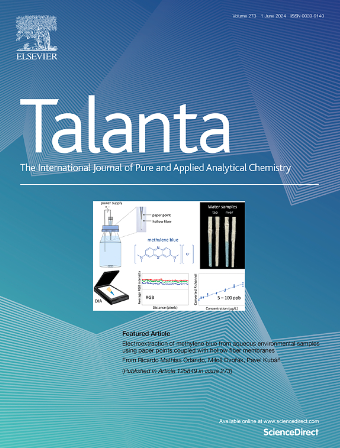Facile fabrication of net-like fluorescent microsphere/AuNP tags for a dual-modal colorimetric/fluorescence lateral flow assay
IF 5.6
1区 化学
Q1 CHEMISTRY, ANALYTICAL
引用次数: 0
Abstract
Lateral flow assays (LFAs) offer a simple and rapid option for diagnosis, widely utilized for point-of-care or at-home testing. However, they often suffer from low sensitivity and high false positive owing to the single output signal. Herein, we developed a dual-mode colorimetry/fluorescence LFA via employing a novel net-like nanprobe as a reporter tag, which was obtained by coupling the fluorescent microspheres (FMs) with gold nanoparticles (AuNPs). Upon the introduction of the target (using miRNA-21 as a model), it hybridizes with the net-like nanprobe, subsequently trapped by the capture DNA immobilized on the test line, producing a prominent visual and fluorescent signal. Benefiting from the outstanding signal amplification capability of FMs/AuNPs nanoprobe, the developed dual-mode LFA enables highly sensitive detection of miRNA-21, with a detection limit (LOD) as low as 1 pM, which is 10 times and 20 times more sensitive than conventional FMs or AuNPs-based LFA, respectively. Additionally, in comparison to the LFA with single output signal, the analytical results of the dual-mode LFA are more reliable owing to the mutual verification of two different signals. Importantly, the platform can detect miRNA-21 in complex serum samples and distinguish cancer cells from normal cells in cell extract samples analysis, determining its great potential for point-of-care tests.

用于双模态比色/荧光侧流分析的网状荧光微球/AuNP标签的简易制备
横向流动测定法(LFAs)提供了一种简单快速的诊断选择,广泛用于护理点或家庭检测。但由于输出信号单一,往往存在灵敏度低、假阳性高的问题。在此,我们通过将荧光微球(FMs)与金纳米颗粒(AuNPs)偶联获得一种新型网状纳米探针作为报告标签,开发了一种双模式比色/荧光LFA。在引入靶标(以miRNA-21为模型)后,它与网状纳米探针杂交,随后被固定在测试线上的捕获DNA捕获,产生显著的视觉和荧光信号。得益于FMs/AuNPs纳米探针出色的信号放大能力,所开发的双模LFA能够对miRNA-21进行高灵敏度检测,检测限(LOD)低至1 pM,灵敏度分别是传统FMs或基于AuNPs的LFA的10倍和20倍。此外,与单输出信号的LFA相比,双模LFA的分析结果由于两种不同信号的相互验证而更加可靠。重要的是,该平台可以检测复杂血清样本中的miRNA-21,并在细胞提取样本分析中区分癌细胞和正常细胞,这决定了其在即时检测中的巨大潜力。
本文章由计算机程序翻译,如有差异,请以英文原文为准。
求助全文
约1分钟内获得全文
求助全文
来源期刊

Talanta
化学-分析化学
CiteScore
12.30
自引率
4.90%
发文量
861
审稿时长
29 days
期刊介绍:
Talanta provides a forum for the publication of original research papers, short communications, and critical reviews in all branches of pure and applied analytical chemistry. Papers are evaluated based on established guidelines, including the fundamental nature of the study, scientific novelty, substantial improvement or advantage over existing technology or methods, and demonstrated analytical applicability. Original research papers on fundamental studies, and on novel sensor and instrumentation developments, are encouraged. Novel or improved applications in areas such as clinical and biological chemistry, environmental analysis, geochemistry, materials science and engineering, and analytical platforms for omics development are welcome.
Analytical performance of methods should be determined, including interference and matrix effects, and methods should be validated by comparison with a standard method, or analysis of a certified reference material. Simple spiking recoveries may not be sufficient. The developed method should especially comprise information on selectivity, sensitivity, detection limits, accuracy, and reliability. However, applying official validation or robustness studies to a routine method or technique does not necessarily constitute novelty. Proper statistical treatment of the data should be provided. Relevant literature should be cited, including related publications by the authors, and authors should discuss how their proposed methodology compares with previously reported methods.
 求助内容:
求助内容: 应助结果提醒方式:
应助结果提醒方式:


